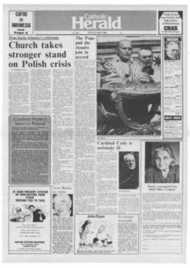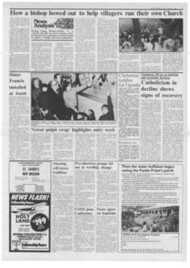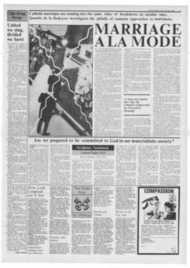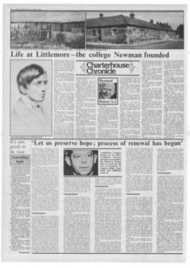Page 2, 15th January 1982
Page 2
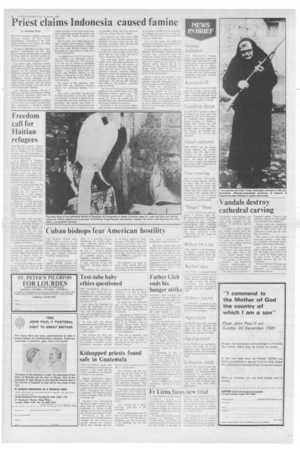
Report an error
Noticed an error on this page?If you've noticed an error in this article please click here to report it.
Tags
Share
Related articles
Land Torn Apart
The Vital Issue Of Timor
Avebury Hits At Indonesia
East Timor Fights On
Telling The Truth About East Timor
Priest claims Indonesia caused famine
by Jonathan Petre
RECENT Indonesian military operations directed against the East Timor independence movement is the main cause of famine in the country, according to Catholic Church sources.
Monsignor Martinho da Costa Lopes, apostolic administrator of Dili, East Timor's capital, has appealed for £160,000 for food, medicine and other supplies by June in order to avert more serious famine in the former Portuguese colony.
In a letter to the Australian Catholic Relief agency, Mgr da Costa Lopes said that crops could not be planted last year because of the military operations. Indonesia annexed East Timor in 1975, while it was still in the hands of the Portuguese. Strong resistance to the brutal invasion has come from the leftwing Fretilin guerrillas with the broad support of the people, more than 50 per cent of whom are Catholics.
East Timorese refugees arriving in Spain say that the indiscriminate killings and brutality continues more than six years after the original invasion.
Two MPs from the Regional Assembly of East Timor were recently arrested after they complained to President Suharto about the behaviour of the occupying troops. Feelings or fear, their report said, were widespread among the people with the result that living conditions had worsened.
The two men, Joao Pedro Soares and Isaac Leandro were arrested in September. but international pressure, including that from some British Catholic M Ps, persuaded the authorities to order their release in December.
A smuggled letter from Church sources first .revealed a new Indonesian military offensive. The letter said: "The intention is to wipe out all Fertilin by dislodging them from their hiding places and forcing them to keep moving 1.rum one place to another ... (to push them) from the Eastern and Western districts to the District of Manatuto in the Middle of East Timor where they will be rounded up by the army.
The tactics of the operation were derived from the traditional volunteer service for combating banditry in a village."
Army tactics apparently included the forcible recruitment of all able bodied men between 15 and 50 to help flush out the guerrillas from their positions in the mountains. The recruits were driven in front of the arim "like African beaters for White hunters. -They are ordered to look
for guerrillas, shout when they see them and even engage them in struggle."
It is reported that more than 50,000 civilians may have been recruited for this operation. Church sources say that the Timorese conscripts "get sick and die from malnutrition and hi. ,,er".
Those who return from the mountains are then too weak to plant crops. As a result Mgr da Costa Lopes has had to make a desperate appeal for aid.
The Australian Relief agency has called on the Indonesian government to allow aid groups into the territory to verify the situation. Mgr do Costa Lopes' letter said that those killed during the operation included "innocent children, pregnant women and defenseless people without (having committed) any crime except the desire to be free rrom all oppression". He said that 500 Timorese were killed in one incident, a four-day siege ()la shrine.
The Church has played an increasingly significant role in East Timor. As a 1980 Indonesian Church report said: "The Indonesian government controls the people by force; the people do not respond freely and voluntarily and look to the Church as their own salvation."
According to the most recent figures there has been a decline in the population
of' more than 100,000, but the proportion of Catholics has risen from 30 per cent before 1975 (the date of' the invasion) to well over 50 per cent.
It is for this reason the Indonesian government is said to have stepped up its campaign to divide the Church.
In December the Indonesian Foreign Minister, Mr Mochtar, claimed that the Vatican was convinced that the integration of East Timor into Indonesia was the best way of ensuring the development and progress of the country. The Minister further claimed that he was informed of the Vatican position by Bishop Pablo Puente or the Vatican Embassy, but the Vatican has neither confirmed or denied this report.
Doubt is cast on the reliability of the Minister's statement by the Vatican's attitude in the past. Although the Vatican has maintained an ambivalent position on East Timor, not contributing, for example, to the annual deliberations by the United Nations on the country, Vatican officials have often stated that they regard the country as "occupied". Timorese argue that it would be contrary to Vatican policy to recognise East Timor as part of Indonesia unless the people or the UN had encouraged this view. which they have not.
blog comments powered by Disqus


